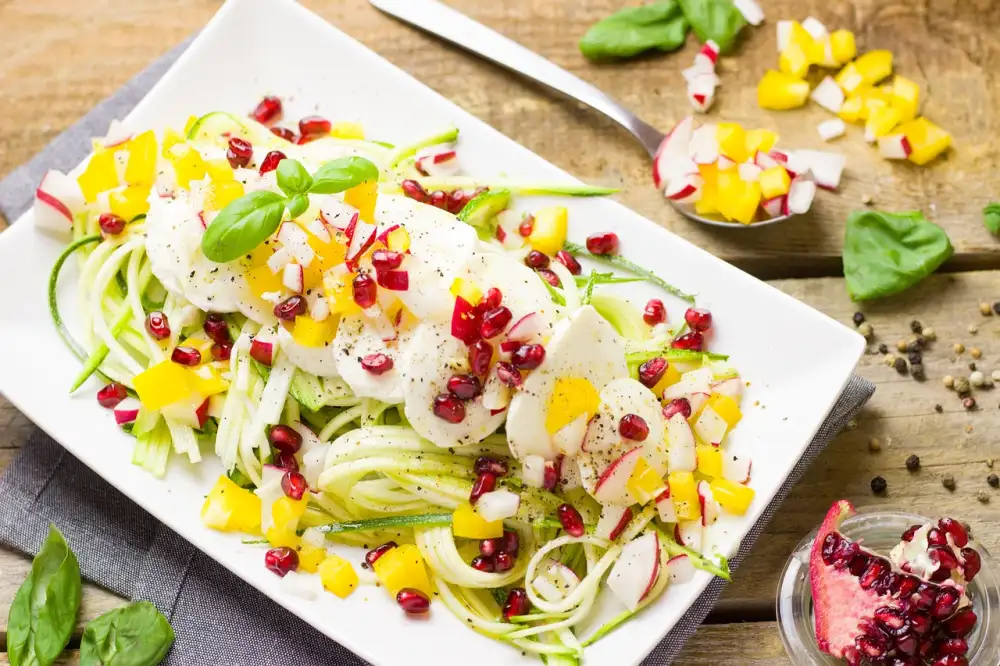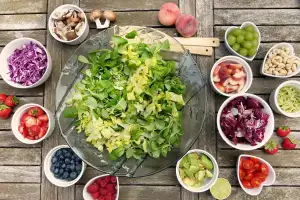Wholesome and Waistline-Friendly: Discover Our Delectable Low Calorie Meals for Optimal Health

- Benefits of Incorporating Healthy Low Calorie Meals into Your Diet
- Key Principles of Creating Healthy Low Calorie Meals
- Nutritious Ingredients for Healthy Low Calorie Meals
- Cooking Techniques for Healthy Low Calorie Meals
- Sample Recipes for Healthy Low Calorie Meals
- Grilled Chicken Salad with Lemon Vinaigrette
- Baked Salmon with Roasted Vegetables
- Quinoa and Vegetable Stir-Fry
- Tips for Meal Planning and Preparing Healthy Low Calorie Meals
In today's fast-paced world, maintaining a healthy lifestyle can be a challenge. However, with the rise of awareness about the importance of nutrition, more and more people are turning to low calorie meals as a way to improve their overall health.
Low calorie meals are not only delicious but also offer numerous benefits for optimal health. By incorporating these wholesome dishes into your diet, you can achieve weight loss goals, boost your energy levels, and reduce the risk of chronic diseases.
Creating healthy low calorie meals is all about balance and making smart choices when it comes to ingredients and cooking techniques. By using nutritious ingredients and employing cooking methods that retain flavor without adding excess calories, you can enjoy satisfying meals without compromising on taste.
In this article, we will explore the key principles of creating healthy low calorie meals and provide you with some mouthwatering recipes to get you started on your journey towards a healthier lifestyle. So let's dive in and discover the world of wholesome and waistline-friendly cuisine!
Benefits of Incorporating Healthy Low Calorie Meals into Your Diet
Incorporating healthy low calorie meals into your diet offers numerous benefits for your overall health and well-being. Firstly, these meals can aid in weight management and promote weight loss, as they help to create a calorie deficit in the body. By consuming fewer calories than you burn, you can shed excess pounds and maintain a healthy weight. Additionally, low calorie meals are often rich in essential nutrients such as vitamins, minerals, and antioxidants. These nutrients support optimal bodily functions and boost your immune system, reducing the risk of chronic diseases like heart disease and diabetes. Moreover, low calorie meals can improve digestion and promote gut health due to their high fiber content. Fiber aids in maintaining regular bowel movements and preventing constipation. Lastly, incorporating these meals into your diet can increase energy levels and improve mental clarity, allowing you to feel more productive throughout the day. By embracing healthy low calorie meals, you can reap these benefits while enjoying delicious and satisfying dishes that nourish both your body and taste buds.
Key Principles of Creating Healthy Low Calorie Meals
When it comes to creating healthy low calorie meals, there are a few key principles to keep in mind. First and foremost, focus on using fresh, whole ingredients. This means incorporating plenty of fruits, vegetables, lean proteins, and whole grains into your meals.
Another important principle is portion control. Pay attention to serving sizes and aim to create balanced meals that include the right amount of each food group. Avoid oversized portions or going back for seconds.
In addition, it's crucial to limit the use of added sugars and unhealthy fats. Opt for natural sweeteners like honey or maple syrup instead of refined sugar, and choose healthier cooking oils like olive oil or avocado oil.
Lastly, don't forget about flavor! Healthy low calorie meals can still be delicious by using herbs, spices, and other seasonings to enhance the taste of your dishes without adding extra calories.
By following these key principles, you can create nutritious and satisfying low calorie meals that will support your overall health and wellness goals.
Nutritious Ingredients for Healthy Low Calorie Meals
When it comes to creating healthy low calorie meals, choosing the right ingredients is key. Opt for nutrient-dense foods that are low in calories but high in vitamins, minerals, and fiber. Incorporate plenty of fresh fruits and vegetables into your meals to add flavor, texture, and a variety of nutrients. Include lean proteins such as chicken breast, turkey, fish, tofu, or legumes to keep you feeling satisfied without adding excess calories. Whole grains like quinoa, brown rice, and whole wheat pasta provide fiber and complex carbohydrates for sustained energy. Don't forget about healthy fats! Add sources like avocado, nuts, seeds, and olive oil in moderation for their heart-healthy benefits. By selecting these nutritious ingredients, you can create delicious low calorie meals that nourish your body while keeping your waistline in check.
Cooking Techniques for Healthy Low Calorie Meals
When it comes to cooking healthy low calorie meals, the right techniques can make all the difference. Here are some cooking techniques that will help you create delicious and nutritious meals without adding extra calories:
1. Grilling: Grilling is a great way to cook lean proteins like chicken, fish, and vegetables. It adds a smoky flavor without the need for oil or butter.
2. Steaming: Steaming is a gentle cooking method that retains the natural flavors and nutrients of ingredients. Use a steamer basket or steam oven to cook vegetables, seafood, and even grains like quinoa.
3. Roasting: Roasting brings out the natural sweetness of vegetables without adding excessive fats or oils. Toss your favorite veggies with a little olive oil, seasonings, and roast them in the oven until tender and caramelized.
4. Stir-frying: Stir-frying quickly cooks ingredients over high heat using minimal oil. This technique preserves the vibrant colors and textures of vegetables while keeping them crisp and flavorful.
5. Baking: Baking is a healthier alternative to frying when it comes to preparing meats or breaded dishes. Use whole wheat breadcrumbs or panko for added fiber and bake until golden brown.
By mastering these cooking techniques, you can create wholesome low calorie meals that are both satisfying and good for your waistline.
Sample Recipes for Healthy Low Calorie Meals
a. Grilled Chicken Salad with Lemon Vinaigrette:
- Marinate chicken breasts in lemon juice, garlic, and herbs.
- Grill until cooked through and slice into strips.
- Toss mixed greens, cherry tomatoes, cucumber, and avocado together.
- Drizzle with a homemade vinaigrette made of lemon juice, olive oil, Dijon mustard, and honey.
- Top with grilled chicken strips for a refreshing and satisfying meal.
b. Baked Salmon with Roasted Vegetables:
- Season salmon fillets with salt, pepper, and your favorite herbs.
- Place on a baking sheet lined with parchment paper.
- Roast at 400°F (200°C) for about 15-20 minutes or until cooked to your desired doneness.
- Meanwhile, toss a variety of colorful vegetables like bell peppers, zucchini, and carrots in olive oil and seasonings.
- Roast the vegetables alongside the salmon until tender and slightly caramelized.
- Serve the baked salmon over the roasted vegetables for a nutritious and flavorful dish.
c. Quinoa and Vegetable Stir-Fry:
- Cook quinoa according to package instructions.
- In a large skillet or wok, heat olive oil over medium-high heat.
- Add diced onions, minced garlic, and your choice of vegetables such as bell peppers, broccoli florets, snap peas, or mushrooms.
- Stir-fry until crisp-tender.
- Push the vegetables to one side of the pan and crack an egg into the empty space. Scramble it quickly before mixing it with the veggies.
- Add cooked quinoa to the skillet along with low-sodium soy sauce or tamari. Toss everything together until well combined.
- Sprinkle with chopped green onions or cilantro for added freshness.
These sample recipes showcase the versatility and deliciousness of low calorie meals. Experiment with different ingredients and flavors to create your own healthy culinary masterpieces!
Grilled Chicken Salad with Lemon Vinaigrette
One of our favorite low calorie meals is the Grilled Chicken Salad with Lemon Vinaigrette. This refreshing and satisfying salad is packed with protein and nutrients, making it a perfect choice for a healthy lunch or dinner.
To make this delicious salad, start by grilling boneless, skinless chicken breasts until they are cooked through and have a nice charred flavor. Slice the grilled chicken into thin strips and set aside.
Next, prepare the lemon vinaigrette by whisking together freshly squeezed lemon juice, extra virgin olive oil, minced garlic, Dijon mustard, honey, salt, and pepper. This tangy dressing adds a burst of flavor to the salad.
In a large bowl, combine mixed greens, cherry tomatoes, cucumber slices, red onion slices, and sliced avocado. Add the grilled chicken on top of the vegetables.
Drizzle the lemon vinaigrette over the salad and toss gently to coat all the ingredients evenly. The combination of the tender grilled chicken with the crisp vegetables and zesty vinaigrette creates a delightful balance of flavors.
This Grilled Chicken Salad with Lemon Vinaigrette is not only delicious but also low in calories and high in nutrients. It provides a good amount of lean protein from the chicken and plenty of vitamins and minerals from the fresh vegetables.
Enjoy this wholesome salad as a light meal on its own or pair it with whole grain bread for added fiber. It's a perfect choice for those looking to maintain a healthy lifestyle without sacrificing taste.
Baked Salmon with Roasted Vegetables
Baked Salmon with Roasted Vegetables is a delightful and nutritious low calorie meal that will tantalize your taste buds. The combination of succulent salmon and flavorful roasted vegetables creates a dish that is both satisfying and waistline-friendly. To prepare this dish, simply season the salmon fillets with salt, pepper, and your favorite herbs. Place them on a baking sheet lined with parchment paper. In a separate bowl, toss your choice of vegetables such as bell peppers, zucchini, and cherry tomatoes with olive oil, garlic, salt, and pepper. Spread the vegetables around the salmon on the baking sheet. Bake in a preheated oven at 400°F for about 15-20 minutes or until the salmon is cooked through and the vegetables are tender. This simple yet delicious recipe is packed with omega-3 fatty acids from the salmon and an array of vitamins and minerals from the roasted vegetables. Enjoy this wholesome meal guilt-free!
Quinoa and Vegetable Stir-Fry
Quinoa and Vegetable Stir-Fry is a delightful and nutritious dish that will satisfy your taste buds without adding extra inches to your waistline. Packed with protein, fiber, and essential vitamins, this recipe is perfect for those looking to incorporate healthy low calorie meals into their diet.
To make this flavorful stir-fry, start by cooking quinoa according to package instructions. Meanwhile, heat olive oil in a large skillet over medium heat. Add minced garlic and chopped onion, sauté until fragrant. Next, add a colorful mix of sliced bell peppers, broccoli florets, and snap peas. Stir-fry until the vegetables are tender yet crisp.
In a small bowl, whisk together low sodium soy sauce, sesame oil, honey (or alternative sweetener), and ginger. Pour the sauce over the vegetables in the skillet and toss to coat evenly. Finally, add the cooked quinoa to the skillet and gently combine all ingredients.
Serve hot and garnish with chopped green onions or cilantro for an added burst of freshness. This Quinoa and Vegetable Stir-Fry is not only visually appealing but also bursting with flavors that will leave you feeling satisfied and nourished.
With just a few simple steps, you can enjoy a wholesome meal that is low in calories but high in nutritional value. So why not give this Quinoa and Vegetable Stir-Fry a try? It's a delicious way to embrace a healthier lifestyle without compromising on taste!
Tips for Meal Planning and Preparing Healthy Low Calorie Meals
1. Plan your meals in advance: Take some time each week to plan out your meals and create a shopping list. This will help you stay organized and ensure that you have all the necessary ingredients on hand.
2. Include a variety of fruits and vegetables: Aim to incorporate a colorful array of fruits and vegetables into your meals. They are low in calories but high in essential nutrients, fiber, and antioxidants.
3. Opt for lean protein sources: Choose lean cuts of meat, such as chicken breast or turkey, and include plant-based protein sources like beans, lentils, or tofu. These options are lower in calories and saturated fats compared to fatty meats.
4. Use healthy cooking methods: Avoid deep-frying or using excessive amounts of oil when cooking. Instead, opt for grilling, baking, steaming, or sautéing with minimal oil to reduce calorie intake.
5. Control portion sizes: Be mindful of portion sizes to avoid overeating. Use smaller plates or bowls to visually trick yourself into thinking you're eating more than you actually are.
6. Prepare meals in advance: Consider meal prepping on weekends by cooking large batches of healthy low-calorie meals that can be portioned out for the week ahead. This will save time during busy weekdays and prevent unhealthy food choices due to lack of time.
7. Keep healthy snacks on hand: Stock your pantry with nutritious snacks like fresh fruit, nuts, yogurt, or cut-up vegetables. Having these readily available will help curb cravings for high-calorie snacks.
By following these tips for meal planning and preparing healthy low-calorie meals, you can easily incorporate wholesome dishes into your diet while still enjoying delicious flavors without compromising on taste or nutrition.
In conclusion, incorporating healthy low calorie meals into your diet is a great way to embrace a healthier lifestyle without sacrificing taste and satisfaction. By following the key principles of creating these meals and using nutritious ingredients, you can enjoy delicious dishes that are good for your waistline and overall health. With the right cooking techniques and meal planning, you can easily prepare these meals at home and make them a regular part of your routine. So why not start today? Discover the joy of wholesome and waistline-friendly cooking, and reap the benefits of optimal health!
Published: 12. 12. 2023
Category: Health



